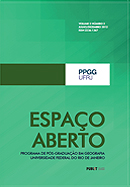Urban Development in Cuba: Reflections on the Photographs in the Book Si Por Cuba
DOI:
https://doi.org/10.36403/espacoaberto.2019.26304Keywords:
Cuba, Urban Space, PhotographyAbstract
Through constructed objects cities materialize social relations that were incorporated into their space at different points in time. Urban space is thus understood as fragmented and articulated; reflex and social condition; symbolic field and struggles. This article has the aim of interpreting the photographs present in Tatiana Altberg’s book Si Por Cuba, using image comprehension modalities in order to reflect on urban development in Cuba and transformations that occurred during the colonial, neocolonial and revolutionary periods. These periods were influenced, respectively, by Spain, the United States and the Cuban Revolution of 1959. The methodology was based on the selection and analysis of five photographs from Altberg’s book, understanding that the images contribute to the process of attributing meaning to reality and so promote new studies focused on the analysis of urban space.


